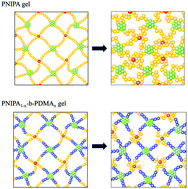Shrinking rates of polymer gels composed of star-shaped polymers of N-isopropylacrylamide and dimethylacrylamide copolymers: the effect of dimethylacrylamide on the crosslinking network†
Abstract
Thermoresponsive polymer gels can be applied as culture beds for cell sheets, drug release agents for drug delivery, and sensing materials. In general, the shrinkage behavior of thermoresponsive polymer gels is complex, and they may require much longer times than swelling to reach thermodynamically stable shrinkage states. This slow volume change during shrinkage is often a drawback in using reversible changes in polymer gel volumes with changing temperature for applications such as those described above, and attempts have been made to improve the shrinkage rates of polymer gels. However, using the conventional method results in a low density of the three-dimensional crosslinked network comprising the polymer gel, which weakens the mechanical properties of the polymer gel. In this study, we investigated the effects of monomer arrangement and composition for star-shaped polymers composed of N-isopropylacrylamide and N,N-dimethylacrylamide on the shrinkage behavior of gels comprising star-shaped polymers with the aim of increasing their shrinkage rates without reducing the network densities of the temperature-responsive polymer gels. Based on selective network decomposition by methanolysis and SAXS measurements, the network structures of the obtained spherical gels were found to be more homogeneous than those of polymer gels obtained by conventional free radical polymerization. These gels exhibited reversible volume changes in water, with low-temperature swelling and high-temperature shrinkage. The rates of volume changes from a high temperature shrunken state to a low temperature swollen one were almost the same for all gels. However, the rates of volume changes from low-temperature swollen states to high-temperature shrunken states varied greatly depending on the compositions and sequences of monomers that made up the polymer networks. We confirmed that the introduction of more than 20% DMA as a block copolymer in the network suppressed phase separation and formation of a skin layer and the water inside the polymer gel drained smoothly to the outside, which resulted in an increase in the shrinkage speed.

- This article is part of the themed collection: Polymer Networks


 Please wait while we load your content...
Please wait while we load your content...